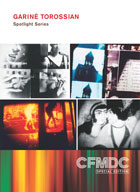
Spotlight Series: Gariné Torossian 2007
Distributed by Canadian Filmmakers Distribution Centre, 401 Richmond St. W., Suite 119, Toronto, Ontario, Canada M5V 3A8; 416-588-0725
Producer n/a
Directed by Gariné Torossian
DVD, color and b&am;w, 79 min.
College - Adult
Film Studies, Media Studies, Fine Arts
Date Entered: 10/14/2009
Reviewed by Oksana Dykyj, Head, Visual Media Resources, Concordia University, MontrealCFMDC’s Spotlight on Gariné Torossian presents 8 of her 16 films including her first from 1992, Visions and ending with her latest from 2005, hypnotize. The other titles include her two seminal films, Girl from Moush (1993) and Drowning in Flames (1994) as well as Pomegranate Tree (1998), Sparklehorse (1999), Babies on the Sun (2001) and Shadowy Encounters (2002).
Torossian’s style of filmmaking draws attention to the most basic component of her work, the strip of film, the celluloid on which images are laid to be projected. She alters the photographed images, transforming them into other objects; she juxtaposes them; and she makes them move outside the original photographed movement in ways that create a kind of rich collage, suggesting another dimension to the moving images with which she began. The moving images of the screen thus become emotionally moving images.
Girl from Moush is somewhat auto-biographical with images of Armenian churches and images from childhood. The memory that the images evoke are like real memories, often true, but sparkled with myth and longing. Many artists have appropriated other artists’ iconic images and have instilled a new archetype from which the image could continue to live on. Torossian’s Drowning in Flames performs this transfiguration with images of the Mona Lisa just as so many other artists have done before her, including Andy Warhol and Marcel Duchamp. She also uses a Rembrandt self-portrait and manipulates it in a way that raises questions about what a self-portrait really embodies. These two films are mesmerizing and rich in texture. The other films on the compilation offer variations in her careful and thoughtful approach, culminating with the last one which was not shot on 16mm film but on video. This Spotlight compilation is highly recommended for academic areas dealing with women in art and film as well as art history and film studies.